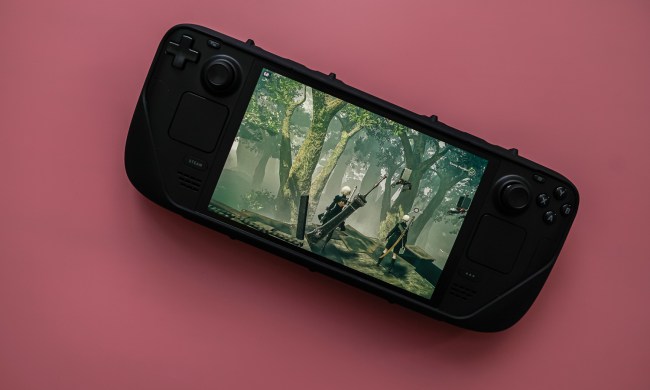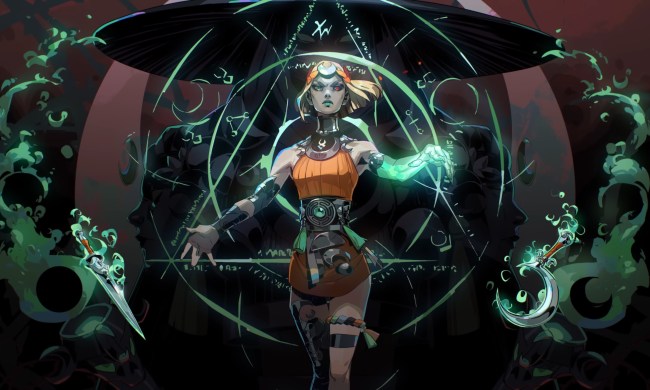The newly announced Steam Deck is the next step in the portable revolution. Starting this December, players will be able to take their entire Steam library on the go thanks to the powerful, Switch-like device. With companies like Microsoft funneling more resources into cloud gaming, we’re inching toward a future where any game can be played anywhere.
That’s undeniably an exciting prospect. The Nintendo Switch is something of a revelation, offering players a level of gaming flexibility that we’d never seen prior to 2017, and the Steam Deck could take it even further. But the shift to full hybrid gaming isn’t quite as simple as cramming every big-budget video game onto a small screen.
Accessibility experts are urging developers to rethink how video game UI is designed to make devices like the Steam Deck more viable to all players.
Too small
If you play a lot of modern video games, you may have found yourself squinting to read the on-screen text at some point. Even on a sizable TV, it can be tough to read minuscule captions or text logs in a game like Control. Naturally, that issue only gets worse when the game is shrunk down to run on a system like the Nintendo Switch — or worse, an iPhone.
That issue is a key concern for Ian Hamilton, an accessibility expert who works with studios to make games more inclusive experiences for disabled players. For Hamilton, tiny on-screen text is already a massive problem that only becomes more challenging on a device like the Steam Deck.
Hey #gamedev #indiedev, here's another reason why you need to be thinking about text size https://t.co/hSubwFmk6H
— Ian Hamilton (@ianhamilton_) July 15, 2021
“While handheld devices do have the advantage of being able to control viewing distance more easily, small text is already a huge issue in games full stop, let alone when shrunk down to a screen only a few inches across,” Hamilton tells Digital Trends. “Contrast is an issue too, due to games on handheld devices being played in varying lighting conditions, on power-saving mode, and so on — trying to read text on an emissive screen in direct sunlight is something we can all relate to, and that’s only amplified for people who have any degree of vision loss.”
Part of the problem comes from the environments games are actually designed in. Hamilton explains that designers often work with a large monitor in front of their faces. When they aren’t working on an individual computer, they might be reviewing their work in a meeting room or “living room” space outfitted with a jumbo screen.
“That’s the primary reason why text size is such an issue, because so often the first time a game is seen in a realistic setting is when a gamer first plays it at home,” says Hamilton. “What looks reasonable in a design environment doesn’t match up with what’s reasonable in a playing environment. It is not uncommon to see console games that have text that’s only 50% of the size it needs to be for someone with full vision to comfortably read it on a regular TV from 10 feet away.”

It’s an ongoing issue that only becomes more urgent as the industry races to give players ultimate flexibility. As it stands, tiny text and UI elements already present a barrier for entry for many players. It has been a recurring complaint for many on social media over the past few years especially. Devices like the Steam Deck only snowball the problem further and highlight exactly why accessibility advocates have called for changes like this.
Game companies want to give us the option to play anywhere, but we’re still not at a point where anyone can play.
Fundamental rethink
If the video game industry is truly all-in on portable experiences, the way games are designed needs to fundamentally change. Hamilton likens it to the challenges the web industry faced a decade ago as users switched from desktops to phones and tablets. That led to innovations like responsive page design, which improved how websites display on mobile devices.
“If you’re reading this on a PC, try slowly dragging the size of the browser window around, right down to very small, look carefully at the individual elements, how the layout changes,” says Hamilton. “Websites didn’t always work like that. Game UI needs to go through a similar renaissance.”

Much of that work needs to be handled at an individual game level, but it isn’t entirely on designers. Platforms like Steam can implement changes that better encourage — or even require — game makers to create more accessible experiences. Hamilton points to Google Stadia’s flag system in its storefront, which calls out what games might have problems at small screen sizes.
“Some platforms and publishers have mandatory accessibility requirements. I think it is highly unlikely that Steam would go this route, it doesn’t really sit with the philosophy of what Steam is,” says Hamilton. “But there are softer routes they could take. For example research; they aren’t short of cash. Pile some of that into solid research, share that with developers, educate them about good practices.”
If hybrid gaming is going to become the norm, the industry needs to get serious about addressing accessibility. Hamilton does see some positive change in that regard when it comes to the Steam Deck. The handheld includes touchpads and rear buttons alongside its standard controller layout. Even better, the device features a USB-C port, which means that players could plug custom accessibility peripherals into the system.
Design considerations like that can go a long way toward making sure our portable future is more accommodating to all players. These are mutually beneficial decisions that will make smaller screens better while improving gaming experiences for players with low vision. The point of cloud gaming or devices like the Steam Deck should be to make video games more accessible, not less.
“Xbox has a nice slogan around accessibility: ‘When everyone plays, we all win.’ “Everyone really does mean everyone; gamers, developers, and platforms alike,” says Hamilton.



